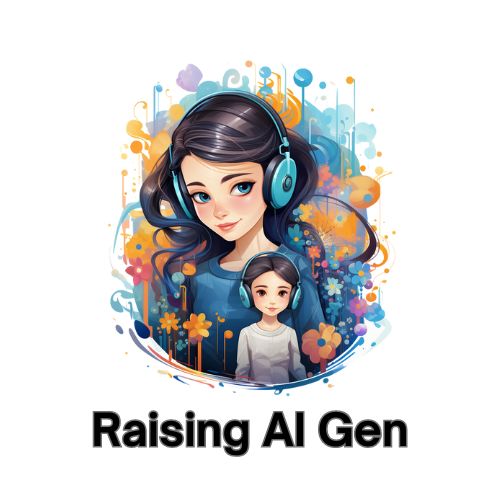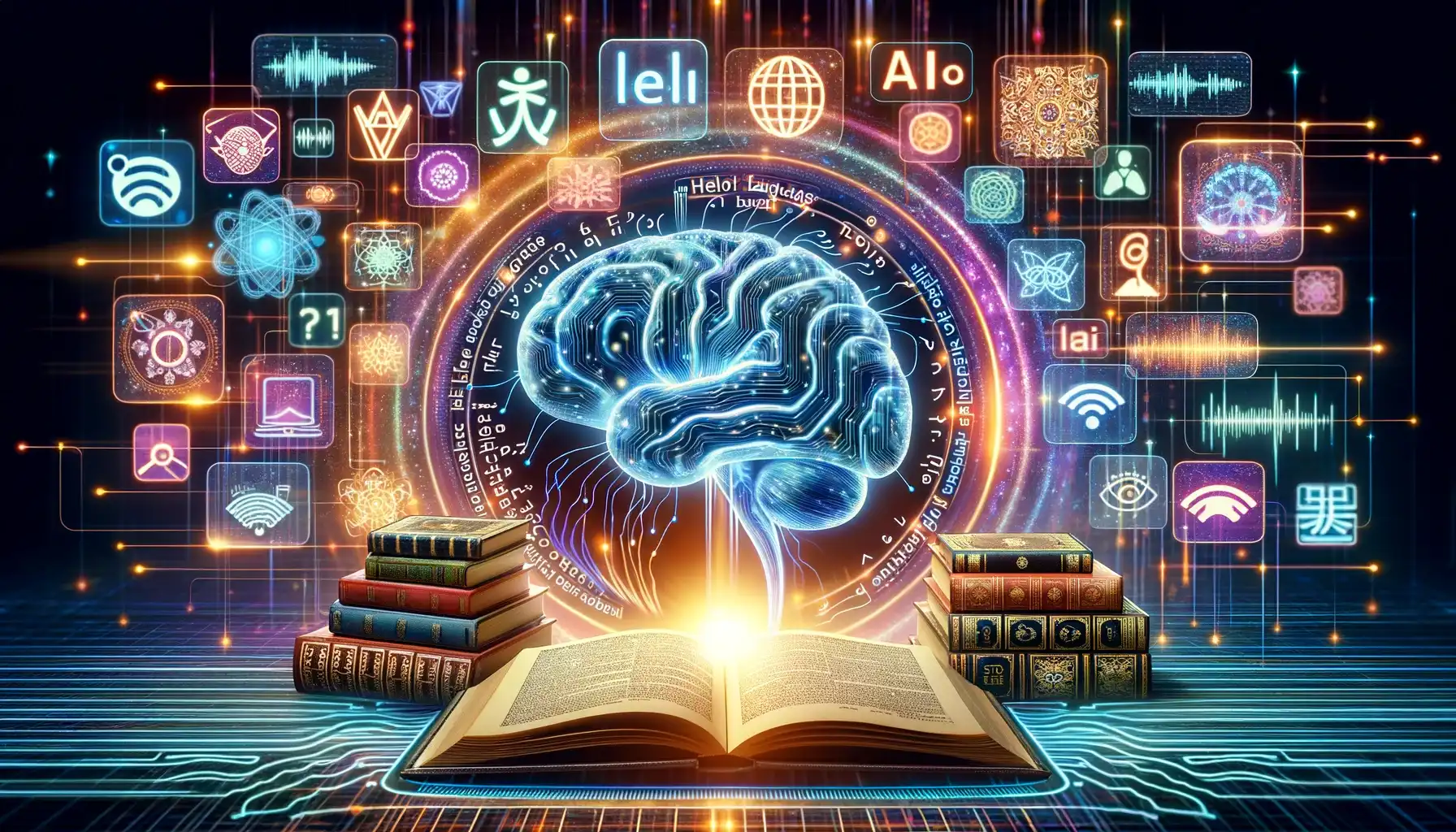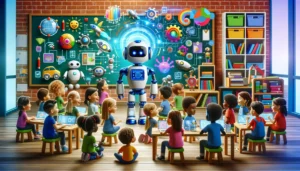In a world where the mastery of multiple languages is not just a cultural treasure but a ticket to diverse opportunities, the traditional methods of language learning are undergoing a dramatic transformation.
The words — AI for Language Learning — is at the forefront of this educational revolution, unlocking doors to personalized, interactive, and effective language acquisition.
This magic key isn’t just for the elite or the tech-savvy; it’s for anyone with a passion for languages and a device to access the digital realm. Intrigued?
Buckle up as we journey through the digital waves reshaping the way we learn languages, making the process not only effective but also enjoyable.
The expedition into the realm of AI for Language Learning unveils how technology augments the conventional classroom, tailoring experiences to meet individual learning aspirations.
As we delve deeper, we’ll explore a medley of AI-powered platforms that are turning the traditional chalk-and-talk approach on its head.
Our sojourn will also touch upon how AI complements conventional teaching methods, forging a blended learning model that’s enriched and engaging.
From real-time feedback to personalized learning trails, the AI-driven language learning ecosystem is bustling with innovations.
It’s not about replacing the human touch in education but enhancing it with intelligent algorithms that adapt to each learner’s pace and preference.
In this exploratory venture, we’ll spotlight some of the pioneering platforms like Duolingo, Babbel, Rosetta Stone, Memrise, Pimsleur, Busuu, italki, and HelloTalk, that are making waves in the ocean of language education.
So, whether you’re a language enthusiast, an educator, or someone just dipping a toe in the multilingual waters, there’s a treasure trove of insights awaiting you.
Key Takeaways
Key Points Insights Personalized Learning AI tailors lessons to individual learning goals and proficiency levels Real-time Feedback Immediate corrections enhance learning efficiency Interactive Practice Engages learners in practical language use Community Engagement Platforms like Busuu and HelloTalk encourage interaction with native speakers Blending with Traditional Methods AI and traditional methods complement each other for holistic learning AI-Powered Platforms Spotlight Discover a variety of platforms leveraging AI for enriched language learning experience
How AI Enhances Language Learning
The integration of Artificial Intelligence (AI) in language learning has burgeoned into a realm of endless possibilities, nurturing a conducive environment for learners to flourish in their linguistic endeavors.
It’s a beautiful marriage of technology and education, each enhancing the other to form a perfect synergy.
Personalized Learning Experiences
One of the most enchanting facets of AI is its ability to cater to the unique learning curves of individuals.
Unlike the one-size-fits-all traditional model, AI for Language Learning tailors the educational tapestry to meet the distinct needs and aspirations of each learner.
- Adaptive Learning Paths: AI algorithms analyze learners’ progress and areas of struggle, adjusting the learning path to fortify weak spots and challenge strengths.
- Customized Content: Whether it’s vocabulary, grammar, or pronunciation, AI curates personalized content, ensuring learners engage with material that’s relevant to their goals.
- Learning Pace: AI respects the rhythm of each learner, accommodating fast learners while providing extra support for those who need a bit more time.
A dive into AI Personalized Learning reveals how this technology is remodeling the educational landscape, making learning a more personalized and enjoyable endeavor.
Real-time Feedback
Immediate feedback is a cornerstone for effective language learning.
AI fills the gap, providing real-time corrections and elucidations, making the learning journey less daunting and more rewarding.
- Error Corrections: Mistakes are invaluable learning opportunities. AI pinpoints errors in grammar, pronunciation, or syntax, providing corrective feedback instantly.
- Pronunciation Assessment: Through speech recognition technology, AI assesses learners’ pronunciation, guiding them towards accurate articulation.
Interactive Practice
The essence of language learning lies in interaction. AI for Language Learning provides a playground for learners to practice their skills in a safe, supportive environment.
- Conversational Bots: Engaging with AI-driven conversational bots allows learners to practice real-world dialogues, enhancing their speaking and comprehension skills.
- Interactive Exercises: From fill-in-the-blanks to sentence construction, interactive exercises provide a hands-on approach to learning.
Automated Assessment
Assessment is crucial for tracking progress and identifying areas for improvement.
AI automates this process, providing detailed insights into learners’ performance.
- Progress Tracking: AI monitors learners’ progress over time, providing a clear picture of their learning trajectory.
- Skill Assessment: By analyzing learners’ interactions and answers, AI gauges their competency in different language aspects, providing a holistic view of their skill set.
Spotlight on AI-Powered Language Learning Platforms
The dawn of AI in the educational sector has brought forth a bouquet of platforms that are harnessing the power of AI to redefine the contours of language learning.
These platforms are not just digital classrooms but are akin to having a personal language tutor at your beck and call.
Let’s venture into the garden of AI-powered language learning platforms and pluck some blossoms that stand tall with their innovative features.
Duolingo
A gamified haven for language enthusiasts, Duolingo employs AI to make language learning a joyful and interactive endeavor.
- Personalized Learning: With AI, Duolingo tailors lessons to match the learners’ ability, ensuring a steady progression.
- Voice Recognition: Perfecting pronunciation becomes less daunting with real-time feedback from AI-powered voice recognition.
Babbel
Babbel’s spotlight shines on making learners conversation-ready by immersing them in real-life dialog scenarios.
- Conversational Practice: It emphasizes practical conversation skills, aided by AI to simulate real-life interactions.
- Review Feature: AI-driven review sessions help reinforce what’s learned.
Rosetta Stone
The legacy of Rosetta Stone in language education is augmented with AI, enhancing the interactive learning experience.
- Speech Recognition: AI-driven speech recognition provides precise feedback on pronunciation.
- Grammar Tracer: AI helps trace grammar usage within conversations, reinforcing grammar rules.
Memrise
Memrise employs spaced repetition algorithms to ensure vocabulary sticks, making the climb to language proficiency a gradual and enjoyable ascent.
- Smart Review: AI optimizes review sessions to reinforce learning, ensuring long-term retention.
Pimsleur
Pimsleur’s audio-focused lessons are enriched with AI, facilitating an engaging auditory learning environment.
- Interactive Conversations: AI-powered dialogues foster interactive learning, bridging the gap between the classroom and real-world conversations.
Busuu
Community engagement is the jewel in Busuu’s crown, fostered by AI-driven features.
- Correction Features: AI-powered corrections in community exercises promote a collaborative learning environment.
italki
With italki, the world becomes your classroom, connecting learners with teachers globally, transcending geographical boundaries.
- Marketplace of Teachers: A vast pool of tutors, enriched with AI tools to match learners with the ideal tutor based on their goals.
HelloTalk
HelloTalk marries social interaction with language learning, creating a vibrant community of learners and native speakers.
- Language Exchange: AI facilitates meaningful interactions, helping learners practice and refine their language skills in a real-world context.
| App | Courses | AI features |
| Duolingo | 100+ languages | Personalized learning, real-time feedback |
| Babbel | 14 languages | Personalized learning, real-time feedback |
| Memrise | 20+ languages | Gamified learning, personalized learning |
| Rosetta Stone | 24 languages | Immersive learning, personalized learning |
| HelloTalk | 150+ languages | Social learning, native speaker feedback |
| italki | 100+ languages | One-on-one lessons with native speakers |
| Pimsleur | 50+ languages | Audio lessons, spaced repetition, real-time feedback |
| Busuu | 12 languages | Social learning, personalized learning, native speaker feedback |
The cornucopia of platforms showcased above is a testament to the endless vistas AI opens up in the domain of language learning. It’s a realm where technology meets culture, and learning blossoms in the confluence.
Through the lens of AI, language learning transcends beyond mere syntax and grammar, nurturing a global community of linguaphiles ready to dive into the tapestry of human communication.
Blending AI with Traditional Learning Methods
The infusion of AI into the realm of language learning isn’t about replacing the tried-and-true traditional methods, but about creating a harmonious blend where each complements the other.
This symbiotic relationship paves the way for a rich, multi-faceted learning experience that cherishes the human touch while embracing the precision and personalization of AI.
The Human Element
The essence of language is communication, a profoundly human endeavor.
The traditional classroom, with its human interaction, cultural discussions, and real-world context, remains invaluable.
- Teacher-led Instructions: Teachers bring a personal touch, understanding, and empathy that AI cannot replicate. Their real-world experiences and cultural insights add a rich layer to language learning.
- Peer Interactions: Learning alongside peers, engaging in discussions, and collaborative projects foster a deep understanding and appreciation of the language and its cultural nuances.
AI for Language Learning as a Complement
AI slides seamlessly into this human-centric model, acting as a powerful tool in the hands of educators and learners alike.
- Personalized Practice: AI offers endless opportunities for personalized practice outside the classroom, solidifying the concepts learned.
- Immediate Feedback: With AI, learners get immediate feedback, allowing them to correct mistakes in real-time, a feature that’s particularly useful in mastering pronunciation and grammar.
- Adaptive Learning Materials: AI’s ability to adapt learning materials to the learner’s level ensures that the learning curve is challenging yet achievable.
Incorporating AI tools within the traditional classroom framework can usher in a new era of language learning, as highlighted in this comprehensive guide on Unlocking the Classroom of the Future.
Creating a Hybrid Learning Environment
A blend of traditional teaching methods with AI-driven tools creates a hybrid learning environment where learners get the best of both worlds.
- Flipped Classrooms: Learners can utilize AI tools for self-study, coming to class prepared for interactive discussions and collaborative projects.
- Customized Learning Paths: Teachers can utilize AI to create customized learning paths, ensuring each learner is challenged according to their level.
Enhancing Engagement and Retention
The marriage of AI and traditional teaching methods fosters an engaging learning environment, promoting better retention and a deeper understanding of the language.
- Interactive Learning: AI tools make learning interactive and fun, promoting engagement and long-term retention.
- Real-world Applications: Traditional methods provide the real-world context, while AI offers the tools to practice and perfect language skills.
The narrative of blending AI with traditional learning methods is about crafting a holistic learning environment. It’s about harnessing the power of AI to enhance, not replace, the human element in language learning.
This blend nurtures a nurturing milieu where learners are motivated to explore, practice, and perfect their language skills in a supportive, interactive setting.
Navigating Challenges and Ethical Considerations
As we sail through the largely uncharted waters of AI for Language Learning, it’s prudent to keep the compass of ethical considerations at hand.
While the horizon is bright with promise, there are challenges and ethical dilemmas that accompany the integration of AI in education, especially in the domain of language learning.
Data Privacy and Security
The cornerstone of personalized learning through AI is data. However, the collection and analysis of data raise significant privacy and security concerns.
- Personal Information: The nature of data collected, be it personal information or learning data, poses privacy concerns.
- Data Handling: How the data is handled, who has access to it, and the measures in place to ensure its security are critical considerations.
Bias and Representativity
AI systems learn from data. Hence, any bias in the data will be mirrored in the AI’s behavior, which could potentially lead to unfair or discriminatory practices.
- Dataset Bias: If the data used to train AI systems lacks diversity, the AI could exhibit biased behavior.
- Cultural Representation: Ensuring that language learning platforms are inclusive and represent a wide array of cultures and dialects is vital.
Teacher and Student Autonomy
While AI serves as a potent tool, it’s imperative that it doesn’t overshadow the autonomy of educators and learners.
- Decision-making: The role of AI should be to assist, not usurp the decision-making process of teachers and students.
- Human Interaction: Maintaining the human element in education is crucial for fostering a nurturing learning environment.
A deep dive into the ethical landscape of AI in education reveals a nuanced interplay of technological innovation and ethical deliberation.
Transparency and Accountability
As AI systems become more integrated into education, ensuring transparency and accountability is paramount.
- Algorithm Transparency: Understanding how AI systems make decisions is crucial for trust and accountability.
- Outcome Explanation: Being able to explain the outcomes generated by AI, especially in assessment scenarios, is vital.
Sustainable Implementation
Ensuring that the implementation of AI in language learning is sustainable and beneficial for all stakeholders is a collective responsibility.
- Long-term Value: Evaluate the long-term value and impact of AI-powered tools on the educational process.
- Affordability and Accessibility: Making AI-powered language learning platforms affordable and accessible to a wider audience is crucial for sustainable implementation.
The voyage into the realm of AI for Language Learning is an exhilarating yet conscientious endeavor.
While we harness the power of AI to foster a rich learning environment, navigating through the ethical fog and tackling the challenges head-on is quintessential for a just and equitable educational landscape.
Peering into the Future: AI and Language Learning
As we stand on the cusp of a digital learning epoch, it’s invigorating to peer into the future of AI for Language Learning.
The seeds sown by innovative AI-powered platforms today are just the harbingers of a lush, technology-enriched educational landscape awaiting us.
Let’s soar on the wings of imagination and glimpse at the potential unfoldings in the domain of language learning, fueled by the indomitable spirit of AI.
Immersive Learning Environments
The future heralds a time when the boundary between the physical and digital realm becomes porous, ushering in immersive learning experiences.
- Virtual Reality (VR) Classrooms: Imagine stepping into a VR classroom where you can interact with historical figures or immerse in the culture of the language you are learning.
- Augmented Reality (AR) Resources: AR could bring learning materials to life, making the learning experience tactile and interactive.
Real-time Translation and Interpretation
With the strides in AI, the babel of languages could morph into a symphony of understanding.
- Seamless Communication: AI-powered real-time translation tools could dissolve language barriers, fostering global communication and understanding.
- Cultural Exchange: Enhanced translation tools can foster cultural exchanges, broadening our horizons and fostering a global community of learners.
AI Tutors and Lifelong Learning
The notion of learning being confined to classrooms could dissolve, with AI becoming a lifelong companion in our educational pursuits.
- On-demand Learning: AI tutors could provide on-demand learning experiences, aiding in both formal education and lifelong learning endeavors.
- Continuous Skill Enhancement: With AI, learning could be a continuous journey, with personalized learning paths evolving as you progress.
A closer look at the role of AI in future classrooms provides a glimpse into how these advancements could transform the education landscape.
Community-driven AI Platforms
The synergy between community engagement and AI could birth platforms that are rich with diverse learning resources.
- Crowdsourced Learning Materials: Community-driven platforms could allow for the creation and sharing of learning materials, enriched by AI algorithms for personalization.
- Peer Teaching and Learning: AI could facilitate peer teaching and learning, leveraging the collective knowledge of the community.
Global Language Learning Communities
The amalgam of AI and digital platforms could nurture global communities where learners, educators, and language enthusiasts converge, transcending geographical and cultural barriers.
- Global Classrooms: Virtual classrooms could host learners and educators from across the globe, fostering a rich exchange of ideas and cultural perspectives.
- Collaborative Learning Experiences: AI could facilitate collaborative projects, connecting learners with complementary skills and interests.
As we venture into the uncharted territories of AI for Language Learning, the narrative is laden with promise and excitement.
It’s a tale of breaking barriers, fostering global communities, and making language learning an engaging, lifelong endeavor.
The fusion of AI with education is not just a leap of innovation; it’s a stride towards a world where the joy of learning is a shared global heritage.
Conclusion: Embracing the AI-Driven Linguistic Voyage
As we anchor at the end of our exploratory voyage through the realms of AI for Language Learning, the panorama before us is both exhilarating and inspiring.
The melding of Artificial Intelligence with the age-old quest for linguistic mastery is a testament to the endless possibilities that burgeon at the crossroads of technology and education.
The narrative we’ve traversed is not merely about algorithmic advancements, but about fostering a global camaraderie of learners and educators, each embarking on their unique linguistic journey, yet interconnected in a vast learning tapestry.
Empowering Individuals and Communities
The heartbeat of AI-driven language learning is empowerment. It’s about putting robust, personalized, and engaging learning experiences within reach of individuals irrespective of geographical or socio-economic boundaries.
- Personalized Pathways: AI for Language Learning crafts personalized pathways, enabling learners to navigate through the linguistic landscape at their pace, guided by AI’s invisible hand.
- Global Learning Communities: The digital platforms burgeon into global classrooms, each click connecting learners with a treasure trove of resources and a vibrant community of like-minded individuals.
Embarking on a journey through the intricate landscape of AI in education, unveils a broader picture of how AI is reshaping the educational sphere, language learning being a gleaming facet of this transformation.
Fostering Lifelong Learning
The AI-driven model heralds a culture of continuous learning. It’s a clarion call to individuals to remain curious, to explore, and to learn, with AI as a steadfast companion.
- Continuous Skill Enhancement: The gamut of AI-powered tools facilitates continuous skill enhancement, making learning an ongoing journey rather than a destination.
- On-demand Learning: The anytime, anywhere accessibility propels a culture of on-demand learning, making education a seamlessly integrated aspect of daily life.
The Road Ahead
The road ahead is laden with promise, with each stride in AI technology opening new vistas in language learning.
It beckons a future where learning is not confined to the four walls of a classroom but is a vibrant, global, and collaborative endeavor.
- Innovative Learning Platforms: As AI continues to evolve, so will the platforms that harness its power, leading to an ever-enriching array of learning resources.
- Ethical & Inclusive Technology: As we move forward, the focus should also be on ensuring the ethical and inclusive implementation of AI, making language learning accessible and beneficial to all.
The narrative of AI for Language Learning is an inspiring saga of how technology can be harnessed to enrich the human experience of learning. It’s a narrative that resonates with the ethos of Raising AIGen, where the fusion of AI with diverse life facets is explored with an eye of curiosity and a spirit of adventure.
As we stand on the brink of a new era in language learning, the call to embrace the AI-driven linguistic voyage resonates loud and clear, promising a journey filled with discovery, camaraderie, and the joy of learning.
Frequently Asked Questions (FAQs)
Below are some common questions and answers regarding AI for Language Learning:
| Question | Answer |
| What is AI for Language Learning? | AI for Language Learning refers to the integration of artificial intelligence technology to facilitate and enhance the process of learning languages. This includes personalized learning experiences, real-time feedback, and interactive lessons among other features. |
| How does AI personalize language learning? | AI personalizes language learning by analyzing individual learner data to understand their learning patterns, strengths, and areas of improvement. It can then tailor lessons, suggest personalized practice exercises, and adjust the level of difficulty to suit the learner’s proficiency and learning pace. |
| Can AI replace teachers in language learning? | No, AI is not meant to replace teachers but to complement their efforts. Teachers bring a human touch, cultural insights, and real-world experiences to the learning process, which AI cannot replicate. AI acts as a tool to enhance and personalize learning, making education more accessible and engaging. |
| What are some popular AI-powered language learning platforms? | Some popular AI-powered language learning platforms include Duolingo, Babbel, Rosetta Stone, Memrise, Pimsleur, Busuu, italki, and HelloTalk. |
| Is data privacy a concern in AI-powered language learning platforms? | Yes, data privacy is a concern as these platforms collect and analyze user data to provide personalized learning experiences. It’s crucial to ensure that the platforms have robust data privacy and security measures in place. |
| How does real-time feedback work in AI language learning platforms? | Real-time feedback in AI language learning platforms is facilitated through technologies like natural language processing and speech recognition. These technologies can provide instant feedback on pronunciation, grammar, and vocabulary usage, aiding in correcting mistakes and enhancing learning. |
| How do AI language learning platforms handle different dialects and accents? | Many AI language learning platforms have started to incorporate diverse dialects and accents to make the learning process more inclusive. They use extensive datasets and advanced algorithms to recognize and accommodate variations in language usage. |
| Are there ethical considerations in implementing AI for language learning? | Yes, there are ethical considerations including data privacy, algorithmic bias, and the preservation of cultural diversity in language representation. Ensuring ethical and inclusive implementation of AI is crucial for a just and equitable educational landscape. |





